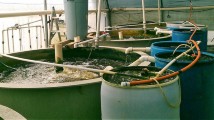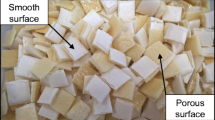Abstract
The objectives of this research were to evaluate the maintenance of water quality when using chitosan foam filters in water recirculation systems during the cultivation of Nile tilapia and to verify the zootechnical performance and the hepatic and branchial histopathological changes, in comparison with the use of biological filter with bioballs. Two Nile tilapia cultivation trials were carried out (trial 1: 35-L tanks; trial 2: 130-L tanks), using six individual water recirculation systems, consisting of a culture tank, decantation tank, submerged pump for recirculation, aeration and external filter. The physical and chemical parameters related to water quality were evaluated every 48 h. At the end of each trial, the fish biometrics was performed to obtain final weight, feed conversion, and survival. In trial 2, the histopathological analysis of the hepatopancreas and gills was performed and the organ index was calculated. The daily averages of the physical and chemical parameters of the water quality, the zootechnical performance of the fish, and the organ indexes of the treatments of trials 1 and 2 were compared by the t test (p ≤ 5%). There were no significant differences in final weight, feed conversion, survival, or organ indexes between treatments (p > 0.05) in relation to the two trials. It was observed that the use of the filter with chitosan foam in the water recirculation systems resulted in lower or equal concentrations of total ammonia, nitrate, and dissolved orthophosphate, and maintained the same or higher alkalinity than in tanks with bioball biological filter. It is recommended to change the chitosan foam every 30 days of cultivation. The use of water recirculation systems with treatment using filters filled with chitosan foam during the cultivation of Nile tilapia is equally effective or better than the use of a biological filter with bioballs.

















Similar content being viewed by others
References
American Public Health Association (APHA). (2005). Standard methods for the examination of water and wastewater (21st ed.). Washington: American Public Health Association.
Atwood, H. L., et al. (2001). Toxicity of nitrite to Nile Tilapia: effect of fish size and environmental chloride. North American Journal of Aquaculture, 63, 49–51. https://doi.org/10.1577/1548-8454(2001)063<0049:TONTNT>2.0.CO.
Baumgarten, M. G. Z. (1996). Manual de análises em oceanografia química. Rio Grande: Ed. Furg 132p. ISBN: 858504246X.
Bernet, D., et al. (1999). Histopathology in fish: proposal for a protocol to assess aquatic pollution. Journal of Fish Diseases, 22, 25–34. https://doi.org/10.1046/j.1365-2761.1999.00134.x.
Boyd, C. E., Tucker, C. S., & Somridhivej, B. (2016). Alkalinity and hardness: critical but elusive concepts in aquaculture. Journal of the World Aquaculture Society, 47, 6–41. https://doi.org/10.1111/jwas.12241.
Bregnballe, J. (2015). A guide to recirculation aquaculture: an introduction to the new environmentally friendly and highly productive closed fish farming systems. Food and Agriculture Organization of the United Nations (FAO) and EUROFISH International Organisation, 100p. http://www.fao.org/3/a-i4626e.pdf. Accessed: 27 June 2020.
Cagol, L., et al. (2016). Concentrações letais de fósforo na água para tilápia do Nilo (Oreochromis niloticus). Acta Iguazu, 5(3), 71–82 http://e-revista.unioeste.br/index.php/actaiguazu/article/download/15847/10756. Accessed: 27 june 2020.
Chung, Y. C. (2006). Improvement of aquaculture wastewater using chitosan of different degrees of deacetylation. Environmental Technology, 27(11), 1199–1208. https://doi.org/10.1080/09593332708618734.
Chung, Y. C., Li, Y. H., & Chen, C. C. (2005). Pollutant removal from aquaculture wastewater using the biopolymer chitosan at different molecular weights. Journal of Environmental Science and Health, Part A: Toxic/Hazardous Substances and Environmental Engineering, 40(9), 1775–1790. https://doi.org/10.1081/ESE-200068058.
Elliott, O., et al. (2017). Design and manufacturing of high surface area 3D-printed media for moving bed bioreactors for wastewater treatment. Journal of Contemporary Water Research and Education, 160(1), 144–156. https://doi.org/10.1111/j.1936-704X.2017.03246.x.
El-Sayed, A.-F. M. (2006). Tilapia culture (277p). Cambridge: CABI Publishing. https://doi.org/10.1079/9780851990149.0000.
El-Sherif, M. S., & El-Feky, A. M. I. (2009). Performance of Nile tilapia (Oreochromis niloticus) fingerlings. II. Influence of different water temperatures. International Journal of Agriculture & Biology, 11, 301–305 08–346/IAZ/2009/11–3–301–305.
Evans, J. J., et al. (2006). Un-ionized ammonia exposure in Nile Tilapia: toxicity, stress response, and susceptibility to Streptococcus agalactiae. North American Journal of Aquaculture, 68, 23–33. https://doi.org/10.1577/A05-032.1.
Garcia-Santos, S., et al. (2007). Alterações histológicas em brânquias de tilápia nilótica Oreochromis niloticus causadas pelo cádmio. Arquivo Brasileiro de Medicina Veterinária e Zootecnia, 59(2), 376–381. https://doi.org/10.1590/S0102-09352007000200017.
Koroleff, F. (1976). Determination of nutrients. In K. Grasshoff (Ed.), Methods of seawater analysis. Weinhein: Verlag Chemie. https://doi.org/10.1002/9783527613984.ch10.
Kubitza, F. (2011). Tilápia: tecnologia e planejamento na produção comercial (2nd ed.). Jundiaí: Acqua Supre Com. Suprim. Aquicultura 316p.
Kyzas, G. Z., & Bikiaris, D. N. (2015). Recent modifications of chitosan for adsorption applications: a critical and systematic review. Marine Drugs, 13, 312–337. https://doi.org/10.3390/md13010312.
Lertsutthiwong, P., et al. (2013). Immobilization of nitrite oxidizing bacteria using biopolymeric chitosan media. Journal of Environmental Sciences, 25(2), 262–267. https://doi.org/10.1016/S1001-0742(12)60059-X.
Liebel, S., Tomotake, M. E. M., & Oliveira, R. C. A. (2013). Fish histopathology as biomarker to evaluate water quality. Ecotoxicology and Environmental Contamination, 8(2), 09–15. https://doi.org/10.5132/eec.2013.02.002.
Macêdo, J. A. B. (2003). Métodos laboratoriais de análises físico-químicas e microbiológicas (2nd ed.). Belo Horizonte: CRQ-MG 450p. ISBN-13: 978-85-909561-3-6.
Marchand, M. J., et al. (2012). Histopathological changes in two potential indicator fish species from a hyper-eutrophic freshwater ecosystem in South Africa: a baseline study. African Journal of Aquatic Science, 37(2), 39–48. https://doi.org/10.2989/16085914.2011.636902.
Marengoni, N. G., et al. (2013). Qualidade física e química da água em sistema fechado de recirculação durante o cultivo de juvenis de tilápia-do-Nilo. Semina: Ciências Agrárias, 34(2), 927–934. https://doi.org/10.5433/1679-0359.
Monsees, H., et al. (2016). Chronic exposure to nitrate sig-nificantly reduces growth and affects the health status of juvenile Nile tilapia (Oreochromis niloticus L.) in recirculating aquaculture systems. Aquaculture Research, 1–11. https://doi.org/10.1111/are.13174.
Moreira, H. L. M., et al. (2001). Fundamentos da Moderna Aquicultura (1st ed.). Canoas: Ed. ULBRA 200p. ISBN 85-7528-020-1.
Patil, I. D., Husain, M., & Rahane, V. R. (2013). Ground water nitrate removal by using chitosan as an adsorbent. International Journal of Modern Engineering Research, 3, 346–349 http://www.ijmer.com/papers/Vol3_Issue1/CF31346349.pdf. Accessed: 27 june 2020.
Pedreira, M. M., et al. (2016). Substrates for biofilter in recirculating system in Nile tilapia larviculture production. Revista Brasileira de Saúde e Produção Animal, 17(3), 553–560. https://doi.org/10.1590/S1519-99402016000300020.
Rašković, B., et al. (2013). Histopathological indicators: a useful fish health monitoring tool in common carp (Cyprinus carpio Linnaeus, 1758) culture. Central European Journal of Biology, 8(10), 975–985. https://doi.org/10.2478/s11535-013-0220-y.
Rebouças, V. T., et al. (2016). Reassessment of the suitable range of water pH for culture of Nile tilapia Oreochromis niloticus L. in eutrophic water. Acta Scientiarum Animal Sciences, 38(4), 361–368. https://doi.org/10.4025/actascianimsci.i4.32051.
Reis, A. B., et al. (2009). Alterações do epitélio branquial e das lamelas de tilápias (Oreochromis niloticus) causadas por mudanças do ambiente aquático em tanques de cultivo intensivo. Pesquisa Veterinária Brasileira, 29(4), 303–311. https://doi.org/10.1590/S0100-736X2009000400005.
Rocha, R. M. et al. (2010). Avaliação histopatológica do fígado de Brachyplatystoma rousseauxii (castelnau, 1855) da baía do Guajará, Belém, Pará. Ciência Animal Brasileira, 11(1), 101–109.
Sandre, L. C. G., et al. (2009). Influência dos fatores climáticos na qualidade de água em pesque-pagues. Veterinária e Zootecnia, 16(3), 509–518 https://www.bvs-vet.org.br/vetindex/periodicos/veterinaria-e-zootecnia/16-(2009)-3/influencia-dos-fatores-climaticos-na-qualidade-de-agua-em-pesque-pague/. Accessed: 27 june 2020.
Silva, M. S. G. M., Losekann, M. E., & Hisano, H. (2013a). Aquicultura: manejo e aproveitamento de efluentes. Jaguariúna: Embrapa Meio Ambiente 39p. https://www.infoteca.cnptia.embrapa.br/bitstream/doc/972692/1/Doc95.pdf. Accessed: 27 june 2020.
Silva, A. D. R., et al. (2013b). Cultivo de tambaqui em canais de abastecimento sob diferentes densidades de peixes. Acta Amazonica, 43(4), 517–523. https://doi.org/10.1590/S0044-59672013000400014.
Sipaúba-Tavares, L. H. (1995). Limnologia aplicada à aquicultura. Jaboticabal: FUNEP 70p.
Statsoft, Inc. (2004). Statistica (data analysis software system), version 7.
Suantika, G., et al. (2016). Ammonium removal by nitrifying bacteria biofilm on limestone and bioball substrate established in freshwater trickling biofilter. Poultry, Fisheries & Wildlife Sciences, 4(2), 157–162. https://doi.org/10.4172/2375-446X.1000157.
Summerfelt, S. T., et al. (2015). Effects of alkalinity on ammonia removal, carbon dioxide stripping, and system pH in semi-commercial scale water recirculating aquaculture systems operated with moving bed bioreactors. Aquacultural Engineering, 65, 46–54. https://doi.org/10.1016/j.aquaeng.2014.11.002.
Vidal, L. V. O., et al. (2008). Eugenol como anestésico para a tilápia-do-Nilo. Pesquisa Agropecuária Brasileira, 43(8), 1069–1074. https://doi.org/10.1590/S0100-204X2008000800017.
Vilbergsson, B., et al. (2016). Taxonomy of means and ends in aquaculture production - part 2: the technical solutions of controlling solids, dissolved gasses and pH. Water Journal, 8(9), 387–407. https://doi.org/10.3390/w8090387.
Zadinelo, I. V., et al. (2018). Adsorption of aquaculture pollutants using a sustainable biopolymer. Environmental Science and Pollution Research, 5(25), 4361–4370. https://doi.org/10.1007/s11356-017-0794-4.
Funding
This study was financed in part by the Coordenação de Aperfeiçoamento de Pessoal de Nível Superior - Brasil (CAPES) - Finance Code 001, and CNPq (Conselho Nacional de Desenvolvimento Científico e. Tecnológico).
Author information
Authors and Affiliations
Corresponding author
Ethics declarations
Conflict of Interest
The authors declare that they have no conflict of interest.
Ethics Approval
The experimental procedures were conducted according to the Ethical Principles of Animal Experimentation adopted by the National Council for the Control of Animal Experimentation (CONCEA), according to protocol no. 10/2018 approved by the Ethics Committee on the Use of Animals of the Palotina Sector of UFPR (CEUA/Palotina).
Additional information
Publisher’s Note
Springer Nature remains neutral with regard to jurisdictional claims in published maps and institutional affiliations.
Rights and permissions
About this article
Cite this article
Zadinelo, I.V., dos Santos, L.D., Alves, H.J. et al. Chitosan Foam–Based Filter: Maintenance of Water Quality for Nile Tilapia Cultivation. Water Air Soil Pollut 231, 532 (2020). https://doi.org/10.1007/s11270-020-04905-3
Received:
Accepted:
Published:
DOI: https://doi.org/10.1007/s11270-020-04905-3




